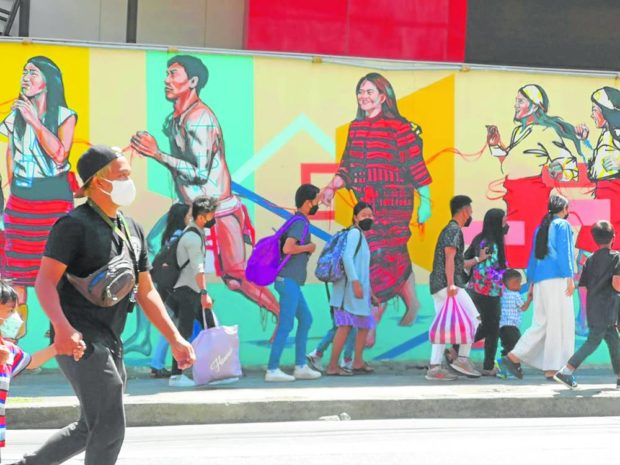
COMING AND GOING | And so Filipinos have to move on — like these travelers at a bus terminal in Baguio City — but with caution and lessons learned from the pandemic. The government says it is preparing a road map for key sectors to move in sync in this direction. (EV ESPIRITU / PHILIPPINE DAILY INQUIRER)
MANILA, Philippines — While the pandemic remains, there are signs that COVID-19 is on its way to becoming endemic in the country, according to infectious diseases expert Dr. Edsel Salvana.
At the Laging Handa briefing on Monday, Salvana said that only the World Health Organization could declare whether the pandemic was over although there were indications the coronavirus was becoming endemic. These include the low transmission of the virus and low hospitalization rate among infected individuals.
“Even if people get sick, because of the high level of vaccination, not too many end up in the hospital. It is virtually like the flu that, even though it still causes deaths, the number is not as high as originally,” he said.
Vaccination brought down the risk of death from COVID-19 tenfold, Salvana said, adding that among the vulnerable population, the risk declined from 10 to 1 percent while among the nonvulnerable, it was down from 1 to 0.1 percent.
He also pointed out that the country now had medicines to treat COVID-19 patients and further decrease their risk of death.
“It’s like going down to the level of flu for everyone in general because we have tools by which we have turned COVID-19 into almost an endemic virus. If we can continue this and no new variant emerges, this will continue toward endemicity,” Salvana said.
But he stressed that Filipinos should continue compliance with measures to prevent a surge in cases, similar to those happening in other countries. These include vaccination, administration of booster shots and the continued wearing of masks.
Another would be to require travelers to present a negative COVID-19 test before being allowed entry into the country.
“Since our vaccination rate is increasing, it offers enough protection especially if people continue to wear masks. And we will continue our pre-departure testing, especially for places with a lot of cases, in order to reduce the risk that somebody with COVID-19 would enter the country,” he said.
According to Salvana, the possibility of another surge in cases remains because the virus has pulled off many surprises, adding that “it’s important to use the tools that we know to be effective to fight COVID-19.”
Weekly bulletin
In the third weekly case bulletin of the Department of Health (DOH), new confirmed COVID-19 cases continued to fall although deaths, most of these reported belatedly, went up in the past week.
The DOH reported that from March 14 to 21, there were 3,572 new cases or an average of 510 daily confirmed cases, down 13 percent compared to 590 in the previous week.
However, there were more deaths reported: 655 compared to 591 the week before.
The latest confirmed deaths that averaged 94 daily included several that happened in 2020.
From March 14 to 21, severe and critical cases went down to 805, from 1,006 in the previous week.
The number of active cases was reported at 45,201 although most of the patients were mildly ill or asymptomatic.
—WITH A REPORT FROM DONA Z. PAZZIBUGAN
RELATED STORY
PH COVID-19 cases drop by 22% – OCTA Research

